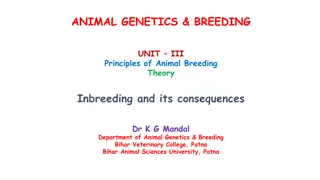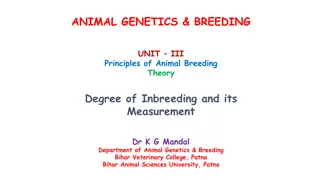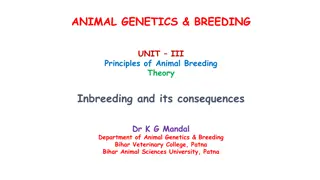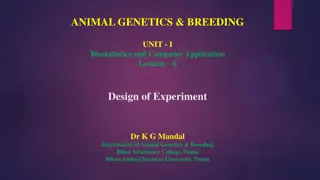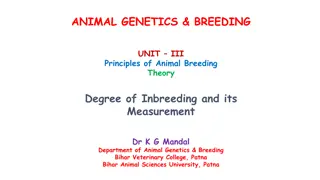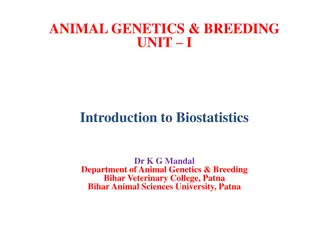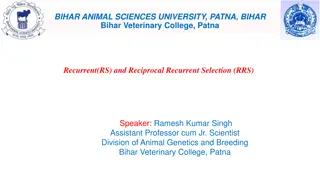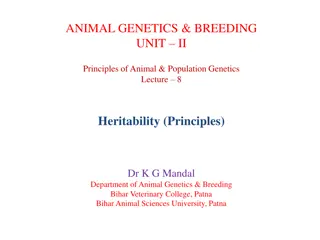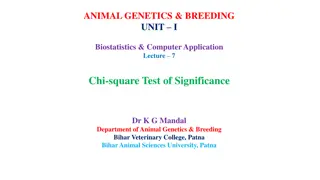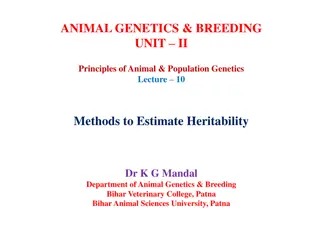Understanding Repeatability in Animal Genetics and Breeding
Repeatability in animal genetics assesses the correlation between repeated measurements of a trait on the same individuals. It partitions phenotypic variance into within-individual and between-individual components, aiding in estimating heritability, resemblance between relatives, and genetic determination. Examples include measuring traits like milk yield, litter size, and wool production over multiple instances. Repeated measurements can be achieved through temporal or spatial repetition, providing insights into the genetic and environmental factors influencing trait expression.
Download Presentation

Please find below an Image/Link to download the presentation.
The content on the website is provided AS IS for your information and personal use only. It may not be sold, licensed, or shared on other websites without obtaining consent from the author. Download presentation by click this link. If you encounter any issues during the download, it is possible that the publisher has removed the file from their server.
E N D
Presentation Transcript
ANIMAL GENETICS & BREEDING UNIT II Principles of Animal & Population Genetics Lecture 8 Repeatability Dr K G Mandal Department of Animal Genetics & Breeding Bihar Veterinary College, Patna Bihar Animal Sciences University, Patna
Importance of partitioning the variance To understand the relative importance of each and every component of variance attributable to the different sources of variation To estimate the relative importance of various determinants of the phenotype, particularly the role of heredity and environment. To determine genetic determination, VG/VP. To estimate heritability of the character, VA/VP. To determine the degree of resemblance between relatives. To determine the repeatability of a character.
Repeatability Repeatability measures the correlation between repeated measurements of a character on the same individuals. When more than one measurement of a character is made on each individual, the phenotypic variance can be partitioned into two components, variance within individual and variance between individuals. The ratio of between individual variance component to the total phenotypic variance is called repeatability.
Examples: The following characters shows repeated measurements on each individual: (i) Lactation Milk Yield it can be measured in subsequent lactations on the same animal. (ii) Litter size it can be obtained in successive pregnancy of litter bearing animals. (iii) Wool production in subsequent shearing of sheep. Several measurements can be obtained from each individual.
Repetition of a character: There are two ways by which repetition of a character may provide multiple measurements : (i) by temporal repetition (ii) by spatial repetition Temporal repetition: The variance of milk yield per lactation or number of young per litter can be partitioned into a component within individuals and a component between individuals. The within individual measures the differences performances of the same individual. variance component between the
The between individual variance component measures the permanent differences between individuals. The within individual variance component is entirely environmental in origin and caused by temporary differences of environment between successive performances. The between individual variance component is partly environmental and partly genetic, the environment part is caused by circumstances that affect the individuals permanently. By this analysis, the variance due to temporary environmental circumstances is separated from the rest and can be measured.
Spatial repetition: The character repeated in space are chiefly structural or anatomical, and are mostly found in plants than in animals. Example: Plants that bear more than one fruit, provide more than one measurement of any character of fruit such as fruit shape and no. seed content. Spatial repetition in animals is chiefly found in characters that can be measured on the two sides of body or on serially repeated segments of body parts, such as number of bristles on the abdominal segments of Drosophila.
In spatially repeated characters the within individual variance environmental in origin but represents the developmental variation arising from localized circumstances operating during development. In both temporal and spatial repetition, the term special environmental variance component will be used to refer to the within individual variance component arising from temporary or localized circumstances and it will be denoted as VEs. And general environmental variance component, VEg, will refer to the environmental variance contributing to the between individual variance component (VG + VEg) and arising from permanent or non-localised circumstances. component is again
The ratio of between individual variance component to the total phenotypic variance is intra-class correlation r . It is the correlation between repeated measurements of the same individual and is known as repeatability. Repeatability, r = (VG + VEg)/VP or, rVP = VG + VEg Therefore, repeatability express the proportion of the variance of single measurements that is due to permanent or non localized differences between individuals to the total phenotypic variance. The special environmental variance component, VEs, as a proportion of total is given by VEs / VP = 1 r or VEs = (1 r)VP
Repeatability Repeatability measures the correlation between measurementsof the traits on the same individual Example milk yield per lactation - Litter size in successive parturition - Wool production in successive shearing - Egg production in subsequent month The phenotype variance (VP) of such characters partitioned into variance within individual (VEs between individuals (VG + VEg). r = ??+??? ?? It ranges from 0 to 1 ??+?? ??+???+??? =
Use of Repeatability To show how much is gained from repeated measurements. To sets upper determination (VG/VP) and heritability (VA/VP). To predict future performance from the past records. limit of genetic
1. To sets upper limit of genetic determination and heritability: Repeatability, r = (VG + VEg)/VP Genetic determination = VG/VP Heritability, h2 = VA/VP Since, (VG + Veg)/VP > VG/VP > VA/VP Hence, r > Genetic determination > h2
2.Gain from repeated measurements: If repeatability is high, little will be gained; if repeatability is low, more will be gained. Only special environmental variance component, VEs, can be reduced by increasing the number of measurements. Then, VP(n) = VG + VEg + 1/n(VEs) This reduction in represents the gain in accuracy. phenotypic variance
The variance of mean of n measurements as a proportion of the variance of one measurement can be expressed in terms of repeatability, as follows: Repeatability, r = (VG + VEg)/VP or, rVP = VG + Veg VEs / VP = 1 r or, VEs = (1 r)VP VP(n) = VG + VEg + 1/n(VEs) = rVP + 1/n(1 r)VP = VP[r + 1/n(1 r)] VP(n)/VP =( nr + 1 r)/n = [1 + (n 1)r]/n
3.Prediction of future performance: If X and Y are first and second performances, x population means, and b is regression coefficient of y on x, then prediction is given by ( Y y) = b(X x). The relationship between regression and correlation coefficient is b = r(6y/6x), where 6x and 6y are the standard deviations. and y are the
Use of repeatability To slow how much is gained from measurements. VP = VG + VEg + VEs VP(n) = VG + VEg + 1/n VEs ??(?) ?? = ?+ ? ? ? ? To set upper limits of genetic determination (VG/VP) and heritability (VA / VP). (VG + Veg)/ VP > VG/VP>VA/VP To predict future performance from record. (Y Y) (X X),
Conclusion When measurements give little gain in accuracy repeatability is high, multiple When repeatability is low, much will be gained in accuracy from multiple measurements The gain in accuracy falls rapidly as the number of measurements increases It is seldom worthwhile to make more than two or three measurements.




